
FDM 3D printers have existed since the late 1980s, but only in the last decade have become affordable 3D printer options for the everyday maker. Unbeknownst to most, there are 4 different types of FDM 3D printer. So, if you are unsure whether a Cartesian 3D printer, Delta 3D printer, Polar 3D printer, or even a Scara 3D printer is best suited to your needs, this article will explain all.
- This article discusses the different types of FDM 3D printer. We also have an article explaining every different type of 3D printer.
This buyer’s guide analyzes the differences between each of the four main types of FDM 3D printer based on your needs, and recommends the 3D printers we feel are best within each 3D printer type. We explain how each type of 3D printing came to prominence, the advantages and disadvantages of each, and niches that each type of FDM 3D printer fulfills especially well.
Cartesian 3D Printers
Cartesian 3D printers are the most common FDM 3D printer type. Name a 3D printer you like, and it will almost certainly be a Cartesian 3D printer. These were the first printers that emerged from the RepRap 3D printer movement over a decade ago that brought 3D printer prices down from tens of thousands of dollars, down to a few hundred currently.
Fun fact: Cartesian FDM 3D printers are named after the Cartesian coordinate mathematical system first discovered by René Descartes back in the 17th century.
These types of FDM 3D printer follow the exact same mathematical pattern: they rely on X, Y, and Z coordinates to place a print head in the correct place to print the plastic filament.
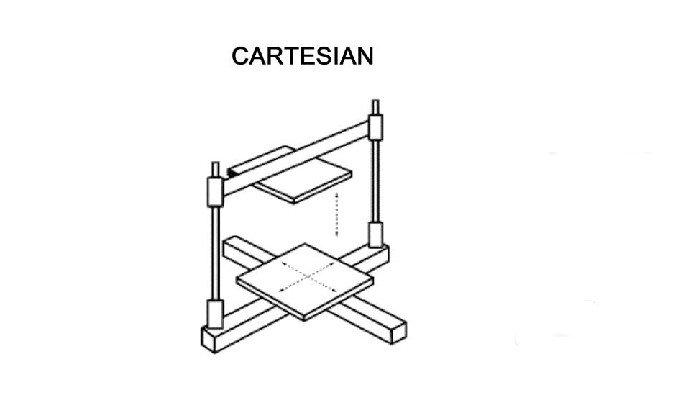
Usually the print head moves on the X- and Y-axes, whilst the print head or bed moves up and down on the Z-axis. Some 3D printers move the extruder up and down for each layer, whereas some Cartesian 3D printers have the print bed move up and down instead. This creates an overall strong printing structure, leading to consistent, accurate and steady prints.
They are simple, reliable and can be easily disassembled and upgraded, leading to a number of excellent 3D printer kits being developed, such as the popular Ender 3.
3DSourced is reader-supported. When you buy through links on our site, we may earn an affiliate commission. Learn more
Best Cartesian 3D Printer Options
| Name and brand | Build volume (mm) | Price | Best price available at: |
|---|---|---|---|
| Creality Ender 3 | 220 x 220 x 250 | $220 | Amazon here |
| Dremel 3D45 | 254 x 154 x 170 | $1,400-$1,900 | Amazon here |
| Ultimaker S3 | 230 x 190 x 200 | $3,850 | Dynamism Store here |
| Raise3D Pro2 | 305 x 305 x 300 | $3,999 | Dynamism Store here |
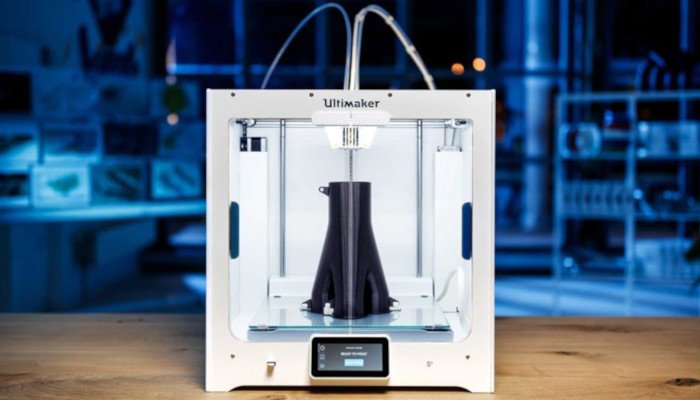
This is why many successful 3D printer companies have opted to build Cartesian FDM 3D printers, including Creality, Makerbot, Ultimaker, Raise3D and many more. Though other types of FDM 3D printer have become more popular in the last two years, Cartesian 3D printers are still the main FDM printer type in use today.
For filaments for Cartesian and Delta 3D printers, we recommend the following:
Delta FDM 3D printers
Though not as popular as Cartesian 3D printers, delta 3D printers are becoming increasingly seen as FDM technology advances and becomes cheaper. Popular Delta 3D printers include FLSUN‘s printers, as well as the very affordable Monoprice Mini Delta.
| Name and brand | Build volume (mm) | Price | Where to buy |
|---|---|---|---|
| Monoprice Mini Delta | 110 x 110 x 120 | $167 | Amazon here |
| FLSUN Q5 | 200 x 200 x 200 | $299 | Amazon here |
| FLSUN QQ-S | 255 x 255 x 360 | $379 | Amazon here |
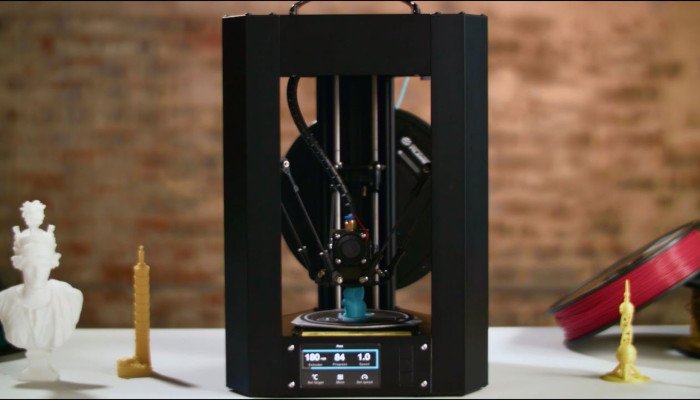
Delta 3D printers involve a circular print bed with a 3D printer extruder featuring three fixed triangular points. Each of these three points can move both upwards and downwards within the cylinder print structure, to be able to place the print head where it needs to be to print.
Delta printers first came to prominence via early RepRap designs, that advanced and became well-loved models like the Rostock and Kossel. Companies like WASP have since taken delta 3D printing to the next level, building some of the fastest 3D printers in the world, as well as delta clay 3D printers.
Overall, Delta 3D printers are very similar to Cartesian printers, though there are some slight differences.
- You can view our full delta 3D printer buyer’s guide here.
Cartesian vs Delta 3D Printers: Comparison
The major difference between these two types of FDM 3D printer is where each printer type can print compared to where the print bed is.
For example, in a Cartesian 3D printer each part can only move in one direction — a certain distance down each axis. However, within a Delta 3D printer, the print head is more flexible and can move in any direction, and instead the print bed stays still.
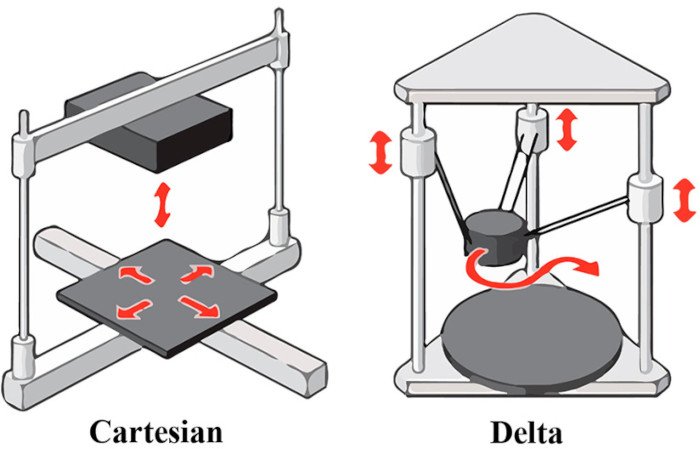
Delta printers are slimmer and taller — they require more height but also offer the ability to print taller structures as a result. So if you’re printing tall parts, go for a Delta 3D printer. Though Cartesian printers must be larger than the same delta printer to have the same build volume, they are consistent and do not lose accuracy towards the edges of the print area.
These differences create a trade-off: Cartesian 3D printers are considered more accurate, with better quality prints; Delta 3D printers are however considered to be faster. The print quality difference, if any, is minimal, whereas the speed of delta 3D printers is exponentially higher than Cartesian 3D printers.
Cartesian 3D printers are also best for printing flexible filaments like TPU, as they often use direct drive extruders which are considered better for flexibles than Bowden extruders, which always feature on delta 3D printers. So for makers looking to print flexible parts, such as 3D printed shoe soles, tires, door stoppers and other parts, you’ll prefer a Cartesian printer.
If you are choosing between a Cartesian 3D printer or a delta printer, think about whether your priority is speed, or print quality and consistency.
Polar 3D Printers
- Notable polar 3D printers: Polar 3D.
Polar 3D printers aren’t as similar to Cartesian printers as Delta, but there are again some aspects that will seem familiar.
They’re called polar because they use a polar coordinate system, whereby every other point on the print bed is determined by its position compared to the central point in the middle of the print bed. This sounds complex, and is difficult for our brains to compute, as each point is not a nominal place but is relative to this central point.

As a result, instead of the square or rectangle print beds on Cartesian printers, Polar 3D printers have circular print beds that rotate and lift up and down to allow for efficient 3D printing.
Fun fact: though the term polar coordinates is attributed to Gregorio Fontana, Alexis Clairaut first conceived of polar coordinates across three dimensions, whilst Swiss mathematician Leonhard Euler was the first person to develop them.
Calculating distance and angle from the central point, with a print bed that spins itself into the correct position, means that an overhanging structure for the extruder and hot end is not required. The L-shaped Polar 3D printer build (rather than cuboid or cylindrical for Cartesian and Delta printers) is efficient, and means that very little maximum build area is lost, with quite large parts printable on a relatively small 3D printer — a massive advantage if you don’t have much space.
Additionally, Polar 3D printers require just two engines to print, working with just angle and length in calculating print areas. On the other hand, Cartesian and Delta printers typically require 3 engines to power each axis. This is theoretically more efficient in terms of energy usage.

SCARA / Robotic Arm 3D Printer
- Example printer: RepRap Morgan, Dobot 3D printer, house 3D printers
The last, and strangest type of FDM 3D printer, are robotic arm 3D printers, also known as SCARA 3D printers.
SCARA stands for Selective Compliance Assembly Robotic Arm.
If you’ve ever been inside an industrial manufacturing plant, or seen clips of one on the news, you’ll have seen huge mechanical arms, welding metals or assembling parts. These robotic arms, used for 3D printing, are scara 3D printers.
Undoubtedly, these are the coolest looking printers. However, we won’t exaggerate like these are already accessible and you can pick one up for a few hundred dollars — these are not cheap like Cartesian printers yet. In fact, most Scara 3D printer applications are in the building of 3D printed houses and other industrial projects.
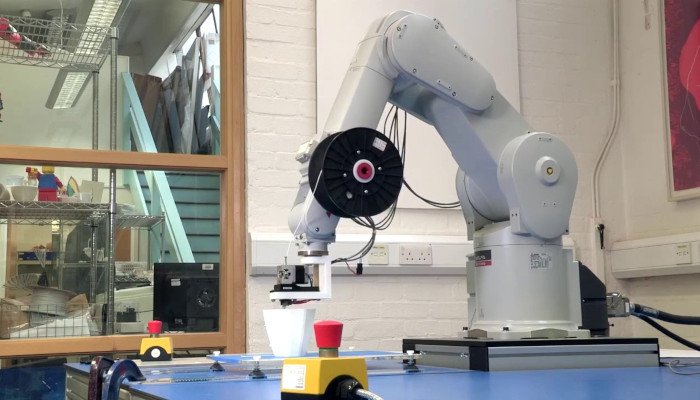
Advantages of robotic arm 3D printers include additional flexibility when printing. This is because printing is not fixed to a print plate and is therefore more mobile and versatile, making it easier to print geometrically complex parts. Scara 3D printers move in the most similar way to human hands, and print faster than Cartesian printers.
However, there are trade-offs with print quality in most cases. When 3D printing large cement walls these slight imperfections aren’t an issue, however when printing intricate, small parts, Scara 3D printers cannot effectively compete with those such as Cartesian or Polar 3D printers.
At a certain size, super large 3D printers have to become Scara 3D printers. This is because for printing huge structures, like houses, you have to be able to move the house 3D printer to the location. Cartesian and delta 3D printers have structures around them, with the large cube or cylindrical structures making them suitable for remaining stationery in a factory, such as for rapid prototyping. Scara 3D printers on the other hand are better suited as industrial 3D printers. Huge robotic arms can be moved to the site of the build, as we have seen with house 3D printing projects like Apis Cor, to deposit layers of cement to build walls.
We expect to see more Scara 3D printers in the future for these industrial house-building projects, so keep an eye out.
That’s it! Hopefully our guide sheds some light on which type of FDM printer is best for your printing needs. If you’re still not completely sure, we have a bunch of other great guides and rankings to help you choose, including:




